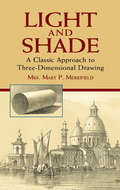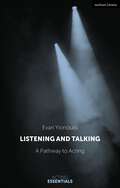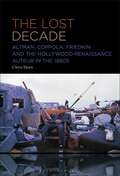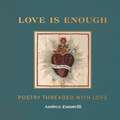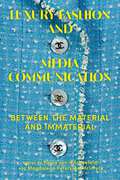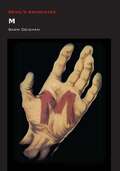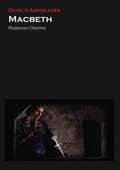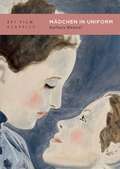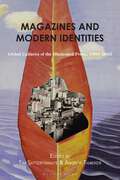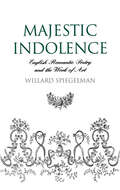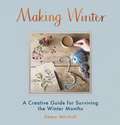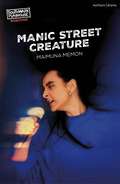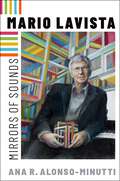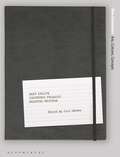- Table View
- List View
Light and Shade: A Classic Approach to Three-Dimensional Drawing
by Mary Merrifield"Form," writes the author, "is developed by means of light and shade; without these every object would appear flat." Originally published in the mid-nineteenth century, this classic approach to three-dimensional drawing was the first book to provide art students with instructions for correctly illustrating perspective outlines of various objects. An art historian noted for her authoritative reference works, Merrifield clearly demonstrates the principles of light and shade by revealing the effects of common daylight, sunshine, and candle or artificial light on geometrical solids. Her simple explanations are accompanied by illustrations of cubes, prisms, pyramids, cylinders, spheres, ovals, and cones.As useful and practical today as it was when first published well over a century ago, Light and Shade provides beginning and advanced art students with valuable insights into effective drawing and sketching.
Listening and Talking: A Pathway to Acting (Acting Essentials)
by Ms Evan YionoulisListening and Talking: A Pathway to Acting provides undergraduate acting students with a clear, achievable, step-by-step way to approach the work of playing a role. The text is supplemented by exclusive video material to take the actor from their first encounter with the text through rehearsals with fellow actors and into performance. Drawing from the author's twenty years' experience of teaching at the Yale School of Drama, this book, which is influenced, too, by the work of legendary teachers such as Konstantin Stanislavski and Uta Hagen, presents a thorough examination of key aspects of the actor's technique (for example, listening, playing an action and pursuing an objective). Throughout, it includes exercises and process points through which students can put into practice the key lessons from each chapter.The practices laid out in this book form a holistic curriculum that not only ensures measurable results over a semester- or year-long course, but also sets in motion an internal process that will serve the student over their life as an artist.
Literary Taste: How to Form It / With Detailed Instructions for Collecting a Complete Library of English Literature
by Arnold BennettAt the beginning a misconception must be removed from the path. Many people, if not most, look on literary taste as an elegant accomplishment, by acquiring which they will complete themselves, and make themselves finally fit as members of a correct society. They are secretly ashamed of their ignorance of literature, in the same way as they would be ashamed of their ignorance of etiquette at a high entertainment, or of their inability to ride a horse if suddenly called upon to do so. There are certain things that a man ought to know, or to know about, and literature is one of them :such is their idea.
The London Eye (Large Print)
This is an image of the London Eye: a Ferris wheel by the side of the River Thames. There is a locator dot shown, which will be at the top left of the page when the image is the right way up.In the centre of the page is the axle, which the wheel rotates around. Radiating out from the centre are the spokes, and all around the circumference are the gondolas in which the passengers sit for their thirty-minute ride. At the bottom of the page are the steps which the passengers climb to get into the gondolas.
The London Eye (UEB Contracted)
This is an image of the London Eye: a Ferris wheel by the side of the River Thames. There is a locator dot shown, which will be at the top left of the page when the image is the right way up.In the centre of the page is the axle, which the wheel rotates around. Radiating out from the centre are the spokes, and all around the circumference are the gondolas in which the passengers sit for their thirty-minute ride. At the bottom of the page are the steps which the passengers climb to get into the gondolas.
The London Eye (UEB Uncontracted)
This is an image of the London Eye: a Ferris wheel by the side of the River Thames. There is a locator dot shown, which will be at the top left of the page when the image is the right way up.In the centre of the page is the axle, which the wheel rotates around. Radiating out from the centre are the spokes, and all around the circumference are the gondolas in which the passengers sit for their thirty-minute ride. At the bottom of the page are the steps which the passengers climb to get into the gondolas.
The Lost Decade: Altman, Coppola, Friedkin and the Hollywood Renaissance Auteur in the 1980s
by Dr. Chris HornProvides an analysis of Hollywood from a fresh viewpoint that shows the careers of Robert Altman, Francis Coppola, William Friedkin, and others in the 1980s as far from conforming to a monolithic pattern of decline, but rather as diverse and complex responses to political and industrial changes.The 1980s are routinely seen as the era of the blockbuster and of 'Reaganite entertainment,' whereas the dominant view of late 1960s and early 1970s American film history is that of a 'Hollywood Renaissance', a relatively brief window of artistry based around a select group of directors. Yet key directors associated with the Renaissance period remained active throughout the 1980s and their work has been obscured or dismissed by a narrow, singular model of American film history.This book deals with industrial contexts that conditioned these directors' ability to work creatively, but it is also very much about the analysis of individual films, bringing to light a range of unheralded work, from the visual experimentation of One from the Heart (Coppola, 1981) to the experimental production contexts of Secret Honor (Altman, 1984) and the stylistic élan of To Live and Die in L.A. (Friedkin, 1985). Behind the homogenous picture of the decline of the auteur in 1980s American cinema are films and careers that merit greater attention, and this book offers a new way to perceive individual films, American film history, and the viability of sustained authorial creativity within post-studio era Hollywood.
Love is Enough: Poetry Threaded with Love (with a Foreword by Florence Welch)
by Andrea ZanatelliIn this truly beautiful book, Andrea Zanatelli combines his extraordinary artworks with a selection of classical love poetry by Anne Brontë, William Blake, Christina Rossetti, Emily Dickinson, Percy Shelley and many more.Drawing its inspiration from the past, Love is Enough references the decorative arts of a bygone era, and is a combination of romantic imagery, antique fabrics and allegorical illustrations, mixed with poems and mottos. Often mistaken for real embroidery pieces, the artworks are in fact very detailed and intricate digital collages, made to look and feel like handcrafted works.Zanatelli is strongly influenced by the Arts and Crafts movement and the Pre-Raphaelites as well as eighteenth-century collage artist and creator of the Flora Delanica, Mary Delany, among others. Recurring themes in his work are romantic love, magical symbols, Victorian era craftsmanship, historical nun’s work and relics. Details of paintings, ancient fabrics, antique jewellery and miniatures are also returning elements as they often become an integral part of the inspiration for the collages themselves.This stunning book is full of intricate detail and brimming with romance, so you can return to its pages again and again.
Luxury Fashion and Media Communication: Between the Material and Immaterial
Using image and film advertisements, interviews, social media and public and private archives, Luxury Fashion and Media Communication offers an interdisciplinary approach to analyzing the value of the luxury object. Regular reports on consumption in media and frequent advertising on social media have allowed people all over the world to share in the issues and development of luxury; but how is it communicated, and how has it affected the consumer?An international range of scholars explore the material and immaterial value and meaning of luxury, how it is materialized and how it is communicated between the luxury industry and the consumer. Investigating French, Italian and Spanish luxury brands and their communication strategies on the global market, and including two chapters focusing specifically on the Chinese and American markets, they examine the ambiguity of the luxury commodity. This volume shows particularly the conflicting narratives between the idea of exclusivity and human skills and their mass marketing.In exploring theoretical perspectives alongside the practicalities of how luxury is communicated, Luxury Fashion and Media Communication reveals the value of the luxury object and the consumer's behaviour in relation to that value. It offers an innovative and important intervention in the inter-related fields of luxury fashion, media and communication, and key reading for scholars, students and practitioners wishing to explore the material and immaterial value of luxury.
M (Devil's Advocates)
by Samm DeighanFritz Lang’s first sound feature, M (1931), is one of the earliest serial killer films in cinema history and laid the foundation for future horror movies and thrillers, particularly those with a disturbed killer as protagonist. Peter Lorre’s child killer, Hans Beckert, is presented as monstrous, yet sympathetic, building on themes presented in the earlier German Expressionist horror films like The Cabinet of Dr. Caligari and The Hands of Orlac. Lang eerily foreshadowed the rising fascist horrors in German society, and transforms his cinematic Berlin into a place of urban terror and paranoia. Samm Deighan explores the way Lang uses horror and thriller tropes in M, particularly in terms of how it functions as a bridge between German Expressionism and Hollywood’s growing fixation on sympathetic killers in the ‘40s. The book also examines how Lang made use of developments within in forensic science and the criminal justice system to portray a somewhat realistic serial killer on screen for the first time, at once capturing how society in the ‘30s and ‘40s viewed such individuals and their crimes and shaping how they would be portrayed on screen in the horror films to come.
Macbeth (Devil's Advocates)
by Rebekah OwensWhy write about Roman Polanski's Macbeth (1971) as part of a series of books dedicated to the classics of the horror movie genre? Because, Rebekah Owens argues, just as Banquo in Polanski's film holds up a series of mirrors that reflect images of his successors that trace back to his own son Fleance, so subsequent milestones in the genre show their lineage to this work, their originator. Polanski had previously made Repulsion (1965) and Rosemary's Baby (1968), so he was fully aware of the conventions of the horror genre and this film provides clues to his own horror lexicon. This book demonstrates how Macbeth can be read as part of the British Folk tradition, strengthening the reading of the film as a horror movie in its own right through its links to The Wicker Man (1973), Blood on Satan's Claw (1971) and Witchfinder General (1968) then argues the case for its recognition as a horror movie even further, by connecting it to the later American horror classics, such as Halloween (1978). It also explores the popular associations made between the film and Polanski's own life, arguing that they endorse the view of the film as a horror. This book represents the first serious attempt to regard Polanski's Macbeth as a horror film in its own right, and not exclusively as one of a multitude of ongoing Shakespeare film adaptations.
Mädchen in Uniform (BFI Film Classics)
by Barbara MennelLeontine Sagan's Mädchen in Uniform (1931) is a groundbreaking German film that showcases women's agency and desire behind and in front of the camera.Adapted from Christa Winsloe's lesbian play, the story follows Manuela, an orphan in a boarding school for impoverished Prussian nobility. When she declares her love with her female teacher, the oppressive principal punishes her, leading to a desperate suicide attempt.Barbara Mennel's compelling study firmly establishes Mädchen in the Weimar cinema canon. Mennel contextualises the film in 1920s theories of sexuality and the conventions of modernist cinema. She contrasts its international success to the extensive censorship battles that surrounded it. The film's unique transnational and fragmented history results from the exile of many of its makers during the Nazi regime. By attending to the many remakes throughout the 20th and 21st century, Mennel underscores the film's timeless impact that continues to resonate with contemporary audiences.
Magazines and Modern Identities: Global Cultures of the Illustrated Press, 1880–1945
In the late nineteenth and early twentieth century, ideals of technological progress and mass consumerism shaped the print cultures of countries across the globe. Magazines in Europe, the USA, Latin America, and Asia inflected a shared internationalism and technological optimism. But there were equally powerful countervailing influences, of patriotic or insurgent nationalism, and of traditionalism, that promoted cultural differentiation. In their editorials, images, and advertisements magazines embodied the tensions between these domestic imperatives and the forces of global modernity.Magazines and Modern Identities explores how these tensions played out in the magazine cultures of ten different countries, describing how publications drew on, resisted, and informed the ideals and visual forms of global modernism. Chapters take in the magazines of Australia, Europe and North America, as well as China, The Soviet Turkic states, and Mexico. With contributions from leading international scholars, the book considers the pioneering developments in European and North American periodicals in the modernist period, whilst expanding the field of enquiry to take in the vibrant magazine cultures of east Asia and Latin America. The construction of these magazines' modern ideals was a complex, dialectical process: in dialogue with international modernism, but equally responsive to their local cultures, and the beliefs and expectations of their readers. Magazines and Modern Identities captures the diversity of these ideals, in periodicals that both embraced and criticised the globalised culture of the technological era.
Making Winter: A Creative Guide for Surviving the Winter Months
by Emma MitchellBanish winter blues and embrace the frosty months by cosying up with Emma Mitchell’s nature-inspired collection of crafts.From delicate silver jewellery, paper-craft decorations and crocheted mittens, to foraged infusions, delicious recipes and nature diaries, Making Winter is filled with projects designed to fend off dreariness in the winter months. Step-by-step instructions and beautiful photographs, shot at Emma’s cottage in the Fens, take you through each project, so that even beginners can enjoy the mood-boosting benefits of a craft-filled winter and snuggle down in their own cosy paradise.
Malayan Classicism: From the Architecture of Empire to Asian Vernacular
by Soon-Tzu SpeechleyThrough a broad range of case studies spanning from imperial monuments to rural residences, Malayan Classicism puts forward a fundamentally new understanding of classical architecture in the Asian colonial context. Across Malaysia and Singapore, thousands of historic buildings are richly ornamented with motifs drawn from Ancient Greece and Rome - as plump volutes, lush acanthus leaves, and neat rows of dentils decorate mosques, palaces, government buildings and innumerable terraced shophouses. These classical details jostle with ideas drawn from other architectural traditions from across Asia in a style that is unique to the region. Presenting the first comprehensive account of what was, prior to World War II, Malaya's most widespread architectural style, Malayan Classicism explores how the classical architecture of the British Empire was transmitted, translated, and transformed in the hands of local builders and architects. Addressing a critical gap in the scholarship, this book charts the metamorphosis of an imperial language of power into a local vernacular style, and provides a new way of reading classical architecture in a post-colonial context that will be applicable throughout the Global South.
Manic Street Creature (Modern Plays)
by Maimuna MemonThere's this unspoken thing right? I guess this resistance to admitting that someone else's trauma can be traumatising.Ria is working with her band to complete a new album – songs charting the rise and fall of a recent relationship. But the more Ria progresses, the more she's drawn back to the darkness of her troubled past, until we're not sure where memory ends and reality begins.Manic Street Creature is a fresh and thrilling take on a modern love story from Olivier nominee (Standing at the Sky's Edge) Maimuna Memon. Love, lust, and late nights collide in a musical roller coaster, taking the audience through the euphoria and distress of two people dealing with their own and each other's mental health.From its multi-award winning run at the Edinburgh Fringe Festival in 2022, including The Scotsman Fringe First, the Mental Health Fringe Award and The Stage Edinburgh Award, this edition of Manic Street Creature is published to coincide with its Southwark Playhouse Borough run in October 2023.
Manifesta, Art, Society and Politics: Creating a New Europe through Contemporary Art
by Erdem ÇolakThis is the first monograph fully dedicated to critically investigating the political, economic, artistic, urban, and societal relationships of Manifesta – European Biennial of Contemporary Art, a European nomadic biennial initiated in the post-Cold War era. Despite being one of the most important recurrent exhibitions taking place in Europe, surprisingly little has been written about it since the mid-2000s, Manifesta, Art, Society and Politics provides a deeply-researched and engaging analysis of the the critically overlooked Manifesta exhibitions, as well as it's changing goals and discourse since the first edition in 1996.The book is split into four parts, divided by theme and following the exhibitions chronologically. Providing a comprehensive overview of one of the most important biennials in Europe, Manifesta, Art, Society and Politics investigates the relationship between large-scale art exhibitions, culture-led regeneration, and urban transformation. It is essential reading for students and researches of exhibition and curatorial studies, art history, and cultural studies.
Manual of Traditional Wood Carving
by Paul N. HasluckDo you want to make an exact replica of a 16th-century carved table? Perhaps, an armchair in carved oak? Maybe, a misericord seat or a 17th-century chair. What about an Italian cassone or coffer, or an ornate 19th-century pipe rack? This book will show you how to make these and many other projects. The book combines practical instruction with numerous photographic illustrations and working diagrams. The summation of years of research and practical work, this volume is the definitive work in English on the craft of traditional wood carving.For the serious-minded beginner, the instructional content is well-organized, easy-to-follow, and very precise. The authors begin with the basics: what tools and appliances are necessary, what woods to use, instruction in the actual cutting of wood. There are chapters on how to translate your ideas into wood, how to design, trace or outline your project. The various methods of practical carving are described; incised, pierced, and chip carving; carving in the round; Gothic carving; styles of carved ornament; etc. Many specific projects are offered: from the simplest — small boxes, bread platters, chests, chairs and stools — to the more complex — tables, cupboards and cabinets, beds, sideboards, even staircases, or for that matter, almost any item you can imagine in wood.Authoritative, complete, and profusely illustrated with 1,146 working drawings and photographic examples, it contains a wealth of encyclopedic information. There is much here you could find nowhere else.
Mario Lavista: Mirrors of Sounds (Currents in Latin American and Iberian Music)
by Ana R. Alonso-MinuttiThis is an open access title available under the terms of a CC BY-NC-ND 4.0 International license. It is free to read at Oxford Scholarship Online and offered as a free PDF download from OUP and selected open access locations. Composer, pianist, editor, writer, and pedagogue Mario Lavista (1943-2021) was a central figure of the cultural and artistic scene in Mexico and one of the leading Ibero-American composers of his generation. His music is often described as evocative and poetic, noted for his meticulous attention to timbre and motivic permutation, and his creative trajectory was characterized by its intersections with the other arts, particularly poetry and painting. Lavista was a relational composer; he did not write music as a private enterprise but for and alongside people with whom he established close relations. Understanding analysis as an affective practice, author Ana R. Alonso-Minutti explores the intertextual connections between the multiple texts--musical or otherwise--that are present in Lavista's music. Alonso-Minutti argues that, through adopting an interdisciplinary and transhistorical approach to music composition, Lavista forged a cosmopolitan imaginary that challenged stereotypes of what Mexican music should sound like. This imaginary becomes a strategy of resistance against imperialist agendas placed upon postcolonial peripheries. Departing from traditional biographical and chronological frameworks that exalt masters and masterworks, the author offers a nuanced, personal narrative informed by conversations with composers, performers, artists, choreographers, poets, writers, and filmmakers. Through an innovative mosaic of methodologies, from archival work, to musical and intertextual analysis, oral history, and (auto)ethnography, this book is the first in-depth study of Lavista's compositional career and offers a contextual panorama of the contemporary music scene in Mexico
Marketing Modernisms: The Architecture and Influence of Charles Reilly
by Peter RichmondArchitect, teacher, journalist, town planner and cultural entrepreneur, Sir Charles Reilly (1874–1948) was a leading figure of the early twentieth-century British architectural scene. Marketing Modernisms is the first book to take an in-depth look at Reilly’s career, tracing his evolving architectural ethos via a series of case studies of his built work. Among other issues, the author considers Reilly’s involvement in cultural enterprises such as the establishment of the Liverpool Repertory Theatre, his journalism, transatlantic links and town-planning theories. Reilly has been largely overlooked by writers of Modernist histories, but this book restores him to deserved prominence
Mary Kelly's Concentric Pedagogy: Selected Writings (New Encounters: Arts, Cultures, Concepts)
by Mary KellySelected and introduced by Juli Carson, this book presents a collection of essential essays, interviews, and never-before published archival materials that trace the development of the teaching of major artist and thinker Mary Kelly, from 1980-2017.As an artist and a theorist, Kelly is known for her foundational contributions to Feminism and Conceptual Art; she is also revered for her innovative pedagogy, which has influenced countless artists, writers and teachers within the international art community. Her description of a feminist practice of concentric pedagogy, centred on the artwork rather the mastery of the teacher, radically changed teaching practice in art studios.Detailing Kelly's innovative pedagogical program, the essays are split into three sections: The Method, which focuses on Kelly's renowned method of “ethical observation” within studio critique; The Project, which explores her notion of what constitutes an artistic project; and Project and Method in the Field which presents, for the first time, a transcription of On the Passage of a Few People though a Rather Brief Period of Time, a performative colloquy commissioned by the Tate Modern and moderated by Kelly in 2015; following this transcription is a portfolio of practicing artists previously enrolled in Kelly's Interdisciplinary Studio Area at UCLA.Mary Kelly's Concentric Pedagogy highlights how contemporary studio teaching practice has been largely informed by Kelly's bold and innovative approach to art pedagogy, evidencing how the intersection of teaching, artistic practice, and radical political engagement can transform our approach to all three. It is essential reading for students and teachers of art and design studio practice, art history and theory, contemporary, and feminist art.
The Masque of the Red Death (Devil's Advocates)
by Steve HabermanThe Masque of the Red Death (1964), the seventh collaboration between producer-director Roger Corman and horror icon Vincent Price, became the crowning achievement for both men, their masterpiece. After the critical and commercial success of House of Usher in 1960, Corman fervently desired to adapt Edgar Allan Poe’s story, ‘The Masque of the Red Death’ as his next project, but the tale took three years to finally become, not Corman’s second Poe film, but his second to last. Its long development benefitted the end result, and the story of its making reveals the persistence and vision of Corman, the artist and entrepreneur of classic horror. In this Devil’s Advocate, Steve Haberman takes an auteurist approach to the film with Corman as the ultimate author of the work. He explores the emergence of Corman’s themes and techniques through directorial control and compares them with the intentions and concerns of the story’s original creator, Poe. In his research, Haberman secured both drafts of the script, the first by Charles Beaumont and the last by R. Wright Campbell, consulted published interviews and met with Corman. The result illuminates not only the film but the profound and profoundly dark world views of both Roger Corman and Edgar Allan Poe.
Mastering Adobe Photoshop Elements: Bring out the best in your images using Adobe Photoshop Elements 2024
by Robin NicholsTake complete control of all your image-editing ambitions using this beautifully illustrated, easy-to-understand, jargon-free guide on Photoshop Elements 2024 packed with best practices and expert insights.Key FeaturesComprehensive coverage of Adobe Photoshop Elements 2024, including new AI-powered tools and advanced featuresPractical guidance on photo organization, editing, and sharing, with an emphasis on creative and professional techniquesRich, illustrative content with updated examples, tutorials, and mini creative projectsBook DescriptionDive into the world of digital photo editing with this latest edition, crafted by Robin Nichols, a seasoned photographer and digital imaging expert, which brings the latest Photoshop Elements 2024 to your fingertips. With a unique blend of in-depth tutorials and practical applications, this book is an essential resource for photographers at all levels. It introduces new features like Dark Mode, Match Color, and Photo Reels, along with advanced techniques like layering and artistic effects. The book also addresses common user feedback from previous editions, ensuring a refined and user-friendly experience. Elements 2024 extends its AI capabilities by simplifying complex editing processes. Learn to stitch widescreen panoramas, remove people from backgrounds, de-focus backgrounds, re-compose images, and even create a range of calendars and greeting cards for your friends and family. Take your prowess to the next level by learning how to correct optical distortion, re-shape images, exploit layers, layer masking, and sharpening techniques—create the perfect picture or imaginative fantasy illustration. You’ll also learn the online realms of animation, video creation, and third-party plug-ins. By the end of this book, you'll learn how to leverage the incredible features of Photoshop Elements 2024 with complete confidence.What you will learnMaster new features in Photoshop Elements 2024, including AI-powered tools and one-click fixes on mobileCreate captivating photo collages, digital paintings, and graphic designsEfficiently organize your photo collections for easy access and managementEnhance your social media presence with professionally edited photos and artworksEmploy advanced layer techniques for more powerful and immersive illustrationsGain comprehensive knowledge to become a proficient Photoshop Elements userWho this book is for"Mastering Adobe Photoshop Elements - 6th Edition" is perfect for photographers of all skill levels - from hobbyists to professionals. Whether you are new to photo editing or looking to upgrade your skills with the latest Photoshop Elements features, this book offers valuable insights and guidance.
